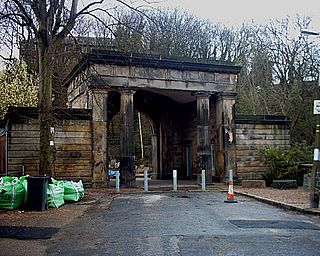The Commonwealth War Graves Commission (CWGC) is an intergovernmental organisation of six independent member states whose principal function is to mark, record and maintain the graves and places of commemoration of Commonwealth of Nations military service members who died in the two World Wars. The Commission is also responsible for commemorating Commonwealth civilians who died as a result of enemy action during World War II. The Commission was founded by Sir Fabian Ware and constituted through Royal Charter in 1917 named the Imperial War Graves Commission. The change to the present name took place in 1960.

Rookwood Cemetery is a heritage-listed cemetery in Rookwood, Sydney, New South Wales, Australia. It the largest necropolis in the Southern Hemisphere and is the world's largest remaining operating cemetery from the Victorian era. It is close to Lidcombe railway station about 17 kilometres west of the Sydney central business district. It was added to the New South Wales State Heritage Register on 2 April 1999.
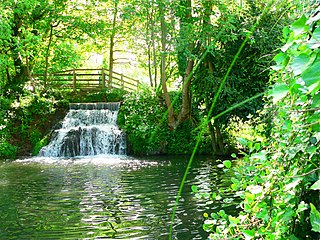
Souchez is a commune in the Pas-de-Calais department in the Hauts-de-France region of France. It is located 3.2 kilometres (2.0 mi) northwest of the Canadian National Vimy Memorial dedicated to the Battle of Vimy Ridge and the missing First World War Canadian soldiers with no known grave; the Memorial is also the site of two Canadian cemeteries.

A war memorial is a building, monument, statue or other edifice to celebrate a war or victory, or to commemorate those who died or were injured in a war.

The Waverley Cemetery is an heritage-listed cemetery on top of the cliffs at Bronte in the eastern suburbs of Sydney, New South Wales, Australia. Opened in 1877 and built by R. Watkins and P. Beddie, the cemetery is noted for its largely intact Victorian and Edwardian monuments. It is regularly cited as being one of the most beautiful cemeteries in the world. The cemetery contains the graves of many significant Australians including the poet Henry Lawson. It is also known as Waverley Cemetery and General Cemetery Waverley. It was added to the New South Wales State Heritage Register on 28 October 2016.
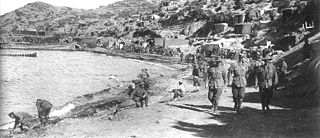
Anzac Cove is a small cove on the Gallipoli peninsula in Turkey. It became famous as the site of World War I landing of the ANZACs on 25 April 1915. The cove is 600 metres (2,000 ft) long, bounded by the headlands of Arıburnu to the north and Little Arıburnu, known as Hell Spit, to the south. Following the landing at Anzac Cove, the beach became the main base for the Australian and New Zealand troops for the eight months of the Gallipoli campaign.

Nunhead Cemetery is one of the Magnificent Seven cemeteries in London, England. It is perhaps the least famous and celebrated of them. The cemetery is located in Nunhead in the London Borough of Southwark and was originally known as All Saints' Cemetery. Nunhead Cemetery was consecrated in 1840 and opened by the London Cemetery Company. It is a Local Nature Reserve.

The Melbourne General Cemetery is a large necropolis located 2 km (1.2 mi) north of the city of Melbourne in the suburb of Carlton North.
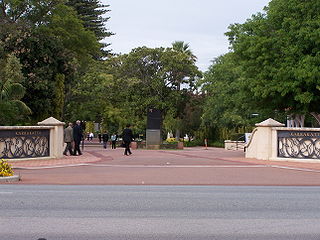
Karrakatta Cemetery is a metropolitan cemetery in the suburb of Karrakatta in Perth, Western Australia. Karrakatta Cemetery first opened for burials in 1899, the first being that of wheelwright Robert Creighton. Managed by the Metropolitan Cemeteries Board, the cemetery attracts more than one million visitors each year. Cypress trees located near the main entrance are a hallmark of Karrakatta Cemetery. The cemetery contains a crematorium, and in 1995 Western Australia's first mausoleum opened at the site.
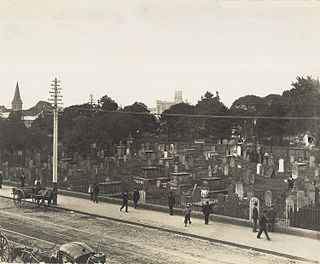
The Devonshire Street Cemetery was located between Eddy Avenue and Elizabeth Street, and between Chalmers and Devonshire Streets, at Brickfield Hill, in Sydney, Australia. It was consecrated in 1820. The Jewish section was used from 1832. By 1860, the cemetery was full, and it was closed in 1867.

Neuville-Saint-Vaast is a commune in the Pas-de-Calais department in the Hauts-de-France region of France. It is located 3.2 kilometres (2.0 mi) south of the Canadian National Vimy Memorial dedicated to the Battle of Vimy Ridge. The Memorial was built on Hill 145, the highest point of the ridge to commemorate the battle and the Canadian soldiers who lost their lives during the First World War. The Memorial is also the site of the Canadian Cemetery No. 2, Neuville-St.-Vaast and Givenchy Road Canadian Cemetery, Neuville-St.-Vaast.

Toowong Cemetery is a heritage-listed cemetery on the corner of Frederick Street and Mt Coot-tha Road, Toowong, City of Brisbane, Queensland, Australia. It was established in 1866 and formally opened in 1875. It is Queensland's largest cemetery and is located on forty-four hectares of land at the corner of Frederick Street and Mount Coot-tha Road approximately four and a half kilometres west of Brisbane. It was previously known as Brisbane General Cemetery. It was added to the Queensland Heritage Register on 31 December 2002.
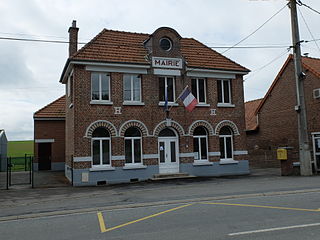
Noreuil is a commune in the Pas-de-Calais department in the Hauts-de-France region of France.

The West Terrace Cemetery is South Australia's oldest cemetery, first appearing on Colonel William Light's 1837 plan of Adelaide. The 27.6 hectares site is located in Park 23 of the Adelaide Park Lands just south-west of the Adelaide city centre, between West Terrace, Anzac Highway, Sir Donald Bradman Drive and the Seaford and Belair railway lines. Originally known as the Adelaide Public Cemetery, it is divided into a number of sections for various communities and faiths, including two Catholic areas, as well as Jewish, Afghan, Islamic and Quaker sections.

"The King's Pilgrimage" is a poem and book about the journey made by King George V in May 1922 to visit the World War I cemeteries and memorials being constructed at the time in France and Belgium by the Imperial War Graves Commission. This journey was part of the wider pilgrimage movement that saw tens of thousands of bereaved relatives from the United Kingdom and the Empire visit the battlefields of the Great War in the years that followed the Armistice. The poem was written by the British author and poet Rudyard Kipling, while the text in the book is attributed to the Australian journalist and author Frank Fox. Aspects of the pilgrimage were also described by Kipling within the short story "The Debt" (1930).

Fromelles Military Cemetery is a First World War cemetery built by the Commonwealth War Graves Commission on the outskirts of Fromelles in northern France, near the Belgian border. Constructed between 2009 and 2010, it was the first new Commonwealth War Graves Commission cemetery for more than 50 years, the last such cemeteries having been built after the Second World War. The cemetery contains the graves of 250 British and Australian soldiers who died on 19 July 1916 in the Battle of Fromelles.

The United Nations Memorial Cemetery in Korea, located at Tanggok in the Nam District, City of Busan, Republic of Korea, is a burial ground for United Nations Command (UNC) casualties of the Korean War. It contains 2,300 graves and is the only United Nations cemetery in the world. Laid out over 14 hectares, the graves are set out in 22 sites designated by the nationalities of the buried servicemembers.

The Tomb of Karl Marx stands in the Eastern cemetery of Highgate Cemetery, north London, England. It commemorates the burial sites of Marx, of his wife, Jenny von Westphalen, and other members of his family. Originally buried in a different part of the Eastern cemetery, the bodies were disinterred and reburied at their present location in 1954. The tomb was designed by Laurence Bradshaw and was unveiled in 1956, in a ceremony led by Harry Pollitt, the General Secretary of the Communist Party of Great Britain, which funded the memorial. The tomb consists of a large bust of Marx in bronze set on a marble pedestal. The pedestal is inscribed with quotes from Marx's works including, on the front, the final words of The Communist Manifesto, "Workers of all lands unite". Since its construction, the tomb has become a place of pilgrimage for followers of Marxist theory. It has also been a target for Marx's opponents, suffering vandalism, and two bomb attacks in the 1970s. It is a Grade I listed structure, the highest listing reserved for buildings and structures of "exceptional interest".
